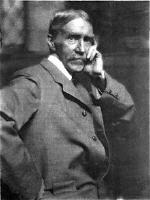
Maurice Prendergast was never a true Impressionist, but he had distant affinities with the movement - he was considerably influenced by Whistler, and by a lesser known figure named Charles Conder, who when very young was one of the "Heidelberg School" painters of tonal impressionist landscape in Australia, but by the early 1890s was painting decorative pictures in Paris.
Prendergast was born in St. John's, Newfoundland, but grew up in Boston. He first visited Paris in 1886, and returned there in the winter of 1890-91, staying three years and studying at the Colarossi Academy and the Academie Julien.
By then, of course, Impressionism was a completely established and accepted style in Paris, and the new tendencies with which alert art students had to contend were Symbolism, Neo-Impressionism -
Seurat,
Signac, and their followers - and the work of
Gauguin, Bonnard, Vuillard, and the circle of the Nabis or "Prophets," such as Serusier and Maurice Denis. Prendergast enthusiastically absorbed their basic doctrine that a painting, before representing anything, should be perceived as a flat surface covered with ordered patches of color. He wasn't much interested in Impressionist "atmosphere"; he evolved a brilliant, sparkling watercolor technique in which the surface became a mosaic of rotund, swirling forms, laid close side by side, with deep perspectives that nevertheless had an air of frontality.
The results, as in one of his Venetian watercolors, Ponte della Paglia, 1898-99, were effervescent. Prendergast's color, clear, direct, and laid on very wet, coalesces in the bubble forms of open parasols red, Prussian blue, beige, white which echo the hues of the buildings, the Grand Canal, and the sky. The sense of luminosity that Venice confirmed in Prendergast's work stayed with him in later years, as his compositions became more friezelike and abstract, with their rag doll people enacting scenes from modern pleasure spots which are at the same time rendered archetypal in all but the modern dress of the figures: beach, park, promenade. The color is opalescent and subtle, the paint surface like that of a thickly plied tapestry. On the Beach, No. 3, c. 1915, is typical. Prendergast, a man steeped in art history and thus in the repertoire of figure poses, was able to give the people on their summer outing a variety of posture and gesture that humanizes their otherwise faceless and schematic bodies: it sets up a gently flowing movement through the frieze, in which memories of Seurat's Grande Jatte mingle with others of
Cezanne, Matisse, and, perhaps, of Piero della Francesca. Such a painting, obviously, has nothing to do with Impressionism. It is an intelligent and sensitive response to the Post-Impressionism that Prendergast encountered in Paris on his later trips, but without the jar and dissonance of Fauve color.